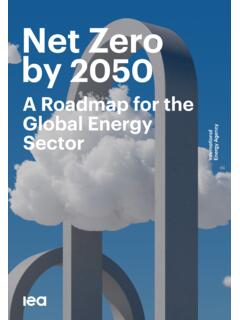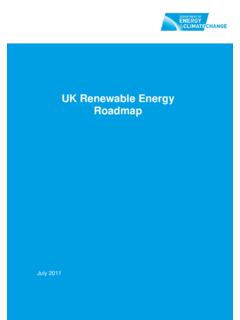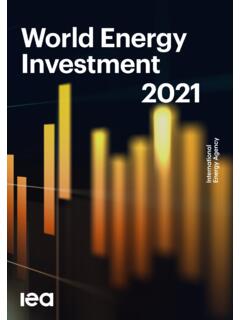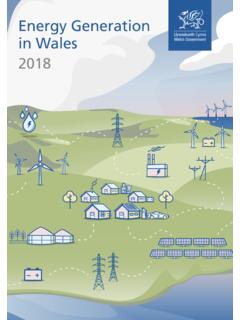Transcription of Wind and Solar on the Power Grid: Myths and Misperceptions ...
1 WIND AND Solar ON THE Power GRID: Myths AND MISPERCEPTIONSGREENING THE GRIDWind and Solar are inherently more variable and uncertain than the traditional dispatchable thermal and hydro generators that have historically provided a majority of grid-supplied electricity. The unique characteristics of variable renewable energy (VRE) resources have resulted in many Misperceptions regarding their contribution to a low-cost and reliable Power grid. Common areas of concern include:1. The potential need for increased operating reserves2. The potential need for increased backup capacity3. The impact of variability and uncertainty on operating costs and pollutant emissions of thermal plants4. The technical limits of VRE penetration rates to maintain grid stability and AND Solar AND THE ROLE OF OPERATING RESERVESThe output of Solar and wind generation is variable over time, driven by weather and the Earth s rotation. Solar and wind generation is also considered uncertain because output cannot be predicted with absolute accuracy.
2 Aggregation of wind and Solar resources decreases variability and reduces the need for additional reserves. The output of a single PV panel or wind turbine can change within a few seconds when clouds pass or the wind stops blowing, but by aggregating geographically dispersed resources, the impact of variability on the whole system can be minimized. Generally, the relative variability of wind and Solar decreases as the generation of more wind and Solar Power plants is combined. Figure 1 shows how aggregating the output of a small set of wind turbines with a larger set has a smoothing effect on the net variability. Power system operators in the have found little need to increase reserve requirements at current levels of wind penetration, and studies have found modest increases at significantly higher penetrations of wind [2]. New forecasting techniques and technologies are helping to reduce uncertainty and thus also reduce the need for systems to hold increased reserves.
3 Spinning reserves reserves that are online and connected to the system are traditionally held to address Power plant failures (contingency reserves) and random variation in demand (regulation reserves). Additional reserves may be needed to respond to unforeseen reductions in output from wind and Solar . The amount of additional reserves needed is largely dependent on the ability to forecast wind and Solar over multiple time periods. Accuracy of wind forecasts has improved with new numerical weather prediction models and statistical approaches. For a single wind Power plant, forecasts that are one to two hours ahead can now achieve mean absolute error rates as low as 5 7% relative to installed wind capacity; this increases to 20% for day-ahead forecasts [3]. Employing the inherent flexibility present in the Power system helps mitigate the modest impacts of renewables. Although ramp rates (rate of change) of the aggregated wind and Solar output can still be significant, Power systems even before the development of VRE technologies are often designed to handle significant variability in loads.
4 Normal demand patterns already vary significantly based on time of day and season, and most Power systems include a variety of generator types, including those designed primarily to cycle and change output [4]. As a result, operators today have observed modest impacts on reserve requirements. Planners have also found that much of the additional reserve requirement is longer duration flexibility reserve, some of which can be met via lower-cost, non-spinning (offline) generators that can start quickly. WIND, Solar , AND THE ROLE OF BACKUP CAPACITYT here are two common uses of the term backup applied to wind and Solar . The first is backup used to address wind and Solar variability. As discussed previously, the variability and uncertainty of wind and Solar can increase ramping and reserve requirements. This variability is best addressed at the system level, and the use of backup plants dedicated to individual wind or Solar generators is economically inefficient.
5 Furthermore, studies and operational practices have found that existing conventional plants that reduce output to accommodate wind and Solar typically can provide the reserves needed to accommodate additional variability. This means that in a reliable electric Power system (one that already meets its planning and operating reserve requirements) the addition of wind or Solar requires no additional generation capacity to accommodate variability of wind or second use of the term backup applies to the limited capacity value of wind and In a system without adequate capacity to meet current or growing load, the addition of wind or Solar may not provide enough capacity value to achieve the reliability goals of the system planner. The Figure 1. At the Power system level, the net variability associated with wind and Solar generation can be smoothed by aggregating multiple geographically dispersed resources. The data in this figure are from the same time period and are normalized to the same scale.
6 Source: Adapted from [1]200 Turbines15 Normalized to Mean81012 Changes to operational practice to access existing Power system flexibility are typically sufficient to handle moderate levels of and Solar generation do not require backup capacity in reliable, sufficient AND Solar ON THE Power GRID: Myths AND Misperceptions capacity value of wind and Solar is typically less than that of an equivalent As a result, a mix of generator types, including conventional generators, may be needed to meet load AND Solar BENEFITS OUTWEIGH PLANT CYCLING COSTS AND EMISSIONSAt significant penetrations of VRE generation, increased variability and uncertainty in the Power system can influence the operation of conventional Power plants, which may need to more frequently and significantly vary their output ( , cycle) to balance demand. This cycling increases plant wear and tear, and operation of thermal plants at partial output lowers fuel efficiency.
7 Even with this increased cycling, recent studies have indicated that VRE can be integrated into Power systems without adverse impacts on system costs or emissions. For example, a study of high penetration scenarios in the Western United States found that lower fuel costs (utilizing less fuel overall) more than offset modest increases in cycling costs. In this study, scenarios where wind and Solar provide 35% of the system s annual demand showed a reduction in projected fuel costs by approximately $7 billion per year, while cycling costs increased by $35 million to $157 million per year. Thus, the cycling costs negated only about 1 2% of the overall operational benefit provided by renewables, resulting in overall large cost savings, primarily due to fuel savings. The study also found that the high RE scenarios led to a net reduction of carbon dioxide (CO2) emissions of 29% 34% across the Western Interconnection, with a negligible impact from the additional emissions associated with increased cycling [3].
8 RELIABILITY AND TECHNICAL LIMITS TO WIND AND Solar PENETRATIONGrid operators have become increasingly able to integrate large amounts of VRE without compromising reliability. In recent years, annual penetrations in certain regions have exceeded 25%, while instantaneous penetrations of wind and Solar routinely exceed 50%, belying concerns about technical limits to renewable reliability is aided by inertia and primary frequency response,3 which are typically provided by conventional thermal generators that help maintain a stable grid in times of disturbances and during normal conditions. Wind and Solar typically do not provide these services in a conventional manner. However, modern wind and some Solar plants now have the ability to provide active Power control services including synthetic inertia, primary frequency response, and automatic generation control (also called secondary frequency response). Studies and recent operational experience have found that when providing active Power control, wind and Solar can provide a very large fraction of a system s energy without a reduction in reliability [5].
9 REFERENCES[1] Milligan, M. and Kirby, B. (2010). Characteristics for Efficient Integration of Variable Generation in the Western Interconnection. NREL/TP-550-48192.[2] Ela, E., Milligan, M., and Kirby, B. (2011). Operating Reserves and Variable Generation. NREL/TP-5500-51978.[3] Lew, D.; Brinkman, G.; Ibanez, E.; et al. (2013). Western Wind and Solar Integration Study Phase 2. NREL/TP-5500-55588.[4] Milligan, M.; Porter K.; DeMeo, E.; et al. (2009). Wind Power Myths Debunked. IEEE Power and energy Magazine. Vol. 7(6): 89-99.[5] Ela, E.; Gevorgian, V.; Fleming, P.; et al. (2014). Active Power Controls from Wind Power : Bridging the Gaps. by P. Denholm and J. Cochran, National renewable energy LaboratoryFigure 2. Wind penetration levels in select countries. Many countries have already integrated high levels of VRE. [Sources: Denmark: The Local. (2015). Danish wind energy has record year. The Local Denmark, Science and Technology. January 6, 2015.]
10 Others: REN21. Renewables 2014: Global Status Report. (2014). Paris, France: REN21]Country% Electricity from WindBalancingDenmark39% in 2014 Interconnection, flexible generation (including CHP), and good marketsPortugal25% in 2013 Interconnection to Spain, gas, hydro, and good marketSpain21% in 2013 Gas, hydro, and good marketIreland18% in 2013 Gas and good market_____1 Capacity value refers to the contribution of a Power plant to reliably meet more information on capacity value, see a related fact sheet, Using Wind and Solar to Reliably Meet Demand. 3 Primary frequency response is the ability of generation (and responsive demand) to increase output (or reduce consumption) in response to a decline in system frequency, and to decrease output (or increase consumption) in response to an increase in system frequency. Primary frequency response takes place within the first few seconds following a change in frequency. Inertia refers to the inherent property of rotating synchronous generators to resist changes in speed (frequency) due to their stored kinetic the Grid provides technical assistance to energy system planners, regulators, and grid operators to overcome challenges associated with integrating variable renewable energy into the MORE INFORMATIONJ ennifer Leisch USAID Office of Global Climate Change Tel: +1-202-712-0760 Email: Cochran National renewable energy Laboratory Tel: +1-303-275-3766 Email.


















